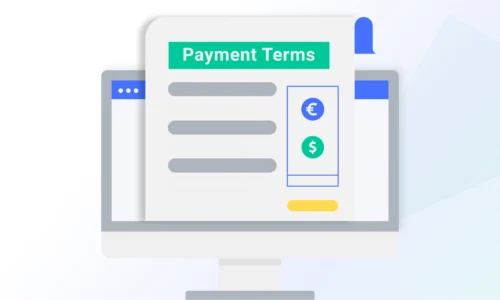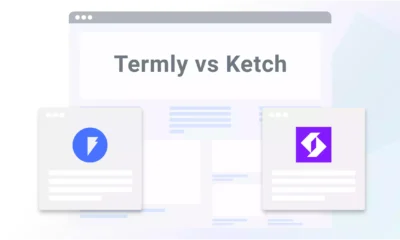These days, there are more ways than ever for customers to make payments — and more ways than ever for customers to avoid payments.
Setting payment terms in your terms and conditions agreement helps maintain healthy customer relationships and steady cash flow.
In this article, I explain what payment terms are and why they’re an essential part of your terms and conditions agreement.
Brief Overview of Terms and Conditions
A terms and conditions agreement is a set of rules between your business and your users that defines what users can, must, and cannot do when using your website or app.
It also explains any conditions users must consent to before accessing your website or app.
Terms and conditions are not legally binding but are a contract directly enforced by your business, and you can enforce them in different ways.
For example, you can implement penalties for prohibited activity, such as restricted access, suspension, or fees, or you can take legal action against people who violate your terms.
If your business includes any paid products or services, include payment terms within your terms and conditions agreement.
What Are Payment Terms?
Payment terms provide the parameters for any online payments to your business, including:
- Setting out accepted forms of electronic payment
- Describing payment dates
- Outlining cancellation rules
- Explaining any late payment penalties
With clear terms set for online payment, you can avoid or minimize late payments and any problematic cashflow issues.
Clear payment terms also help to maintain positive relationships with customers because they’ll know what to expect from the beginning.
Types of Payment Terms
The different types of payment terms include:
- Payment of subscriptions and fees: If your business offers a monthly or annual subscription and provides continuous service for a regularly paid fee, this type of payment term outlines the length of the billing cycle and the accepted payment methods for your products or services.
- Payment of taxes: This type of notice explains that invoices or receipts may include a charge for sales tax based on state or regional laws.
- Cancellation terms: If the customer needs to cancel an order or a subscription, the cancellation terms outline how to do that and whether or not any cancellation fees or refunds are imposed.
- Returns: Your return policy can also be a type of payment term, as it defines whether or not returns are allowed and if returns constitute a refund or a replacement order.
- Currency and authorized payments: This notice explains what currency and type of payments are allowed — for instance, some online store hosts allow third-party payments like PayPal, some allow credit or debit card payments with a fee, and others may require an electronic check.
- Late payments: Late payment terms explain what happens if payment isn’t received in a timely fashion. You might send a warning or suspend service until payment is resumed, and a late fee may also be attached.
- Automatic payment reminders: Using automated payment reminders can help you avoid the use of sending warnings or even suspending services, and a late fee may also be attached.
Why You Need Payment Terms
If payment transactions are a part of your website or app, you need payment terms because they provide three key benefits:
Maximum Legal Protection
Drafting custom payment terms within the limits of applicable laws enables you to enjoy the maximum degree of legal protection allowed.
If you don’t have payment terms, default payment rules contained in those laws apply to the payment, and they may not be as favorable to you, possibly leaving you with less protection.
Minimizing Legal Risks
Payment terms can also protect you from legal disputes or customer demands for refunds who did not thoroughly review the terms and conditions before agreeing to them.
You can point to your express terms and the customer’s agreement with them, thus helping prove you’re not at fault.
Earning Customer Trust With Transparency
To earn customer trust, businesses must be transparent and ensure there’s no confusion regarding payments.
Adding payment terms to your terms and conditions ensures everything is self-explanatory, leaving no ambiguities.
Customers should know what to pay, how, and when.
For example, if your website or app uses autopay for subscription services, let customers know when to expect the payment and how much it will be.
Your terms and conditions should lay out everything users need to know about the relationship between business and customer before engaging with your website.
How To Determine Payment Terms
To determine your payment terms, take a look at your business model and ask:
- Do you have an online shop or offer a service for a subscription cost?
- Do you ship items, or are all your products and services digital?
- Do you have international customers, or is your customer base domestic?
To break this process down further, ask yourself these six additional questions:
- WHO is paying you for products and services?
- WHAT amount should they pay?
- WHEN will that payment be due? Upon purchase? After a particular billing cycle?
- WHERE are your customers located, and what currency will be accepted? Do you have a way to convert currency? Where will the products go after payment?
- WHY are they making this purchase? What is the product or service?
- HOW will they pay? What are your authorized payment methods?
From there, you can begin to draft your payment terms.
Remember to consider legal regulations where you operate and where your customers are located, and look at terms from similar websites as examples for your payment terms.
Examples of Payment Terms
If you’re still drafting your payment terms for your terms and conditions, it may be helpful to look at payment term examples that already exist.
Below are the most common payment terms you may want to add to your terms and conditions agreement.
When Payments Are Due, Subscriptions, and Invoicing
Your payment terms should clearly explain three important features — payment due dates, subscription information, and invoicing details.
Payment Due Dates
The first thing customers want to know once they see a price for a product or service is when payments are due.
For online shops, payments might be due upon purchase, or you might not take the payment out until the product ships — include this information directly in your payment terms.
Subscription Services
If you offer subscription services, explain in your terms:
- If you have a monthly or annual billing cycle
- If the annual billing cycle costs less in the long run than the 12 months of the monthly billing cycle
- If the monthly billing cycle breaks it down into smaller payments
By offering both options in your payment terms, you can meet the preferences and budgets of various customers.
Both billing cycles are often handled by autopay using the payment method the customer indicates on their profile, which they should be able to change at will.
Once the automatic payment comes out, you should email the customer a receipt to confirm they made the payment.
Invoices
If your business has an invoicing model, your payment terms should also include what to expect for invoicing, like:
- When does the invoice come out
- Once the invoice is sent, how long does the customer have to pay the invoice
- What are the penalties for late payment, if any
Write this information clearly in the payment terms section of your terms and conditions.
What Payment Methods You Accept
Next, your payment terms should explain what your acceptable payment methods are:
- Credit or debit card payments: Many online stores accept credit and debit cards as their primary form of payment.
- Store credit options: You may offer a store credit card to qualifying customers, allowing them to make manageable monthly payments rather than paying upon purchase.
- Third-party services: You may have a widget that allows customers to pay through services like PayPal.
Remember to outline in your payment terms if you charge processing fees for credit or debit cards — businesses who do this typically offer the option to pay through an electronic check instead to forego processing fees.
What Currencies You Accept
Another issue that arises when the question of acceptable payment methods comes up is what currencies your business accepts.
Some web hosts, like Shopify and WordPress, have features to automatically convert currency based on the customer’s country of origin.
If this isn’t an option for you, determine what currencies you can accept and list them.
When just starting out, many businesses that ship goods limit their customer base to specific countries — if this is your case, you may only accept one type of currency.
Incentives and Offers for Customers (Or Potential Customers)
Incentives and offers can be part of your terms and conditions, but be clear about limitations and say if there’s an expiration date.
Include information about store or rewards cards for qualifying customers in your payment terms, and explain how to apply and what kind of customers are eligible.
What Happens if Payments Are Missed or Not Received?
Explain in your payment terms what happens if a customer payment is not received.
Even with autopay, payments can get missed, the customer payment method may expire, or they may not have sufficient funds.
While this is often an easy fix for customers, in some cases, it could take days.
The main penalties for late payments in the digital world include:
- A service suspension until payment goes through
- A warning that gives customers a grace period of a few days to make the payment
- Implementing late payment fees after a certain period
No customer likes to suffer penalties for late payments, and no business wants to implement them, but it’s essential to have clear, firm rules for all occurrences, even those that aren’t ideal.
Best Practices for Adding a Payment Terms Clause to Your Terms and Conditions
Knowing what to include in your terms and conditions is one thing, but knowing how to define payment terms is another, so I’ve included best practices to keep in mind in the next section.
Consider the Mandatory Legal Rules
Depending on the location of your business and customers, payment transactions may be subject to mandatory legal requirements.
For example, consumer laws across the world may restrict your freedom to set payment terms to some extent, so consider all legal restrictions when drafting them.
Use Succinct Language
If you use straightforward language in your payment terms, customers are more likely to read them and thoroughly and understand them.
The more concise your wording, the clearer it will be to readers.
Using legalese or unnecessary jargon makes your payment terms harder to understand, and customers may decide not to read long blocks of text.
Be Polite
Use kind language in your payment terms so you don’t put customers on the defensive but still inform them of your expectations.
There’s no need to be aggressive — you’re laying down the law but can do so in a polite and understanding tone.
Assume your customers intend to abide by these payment terms, even if unexpected issues might occur.
Set Specific Deadlines
When it comes to money, every term should be specific and leave no room for misunderstanding, so set specific payment deadlines.
Make your payment terms explicit regarding the billing cycle’s length, the expected time to pay after an invoice is sent, and the time before any late fees will be incurred.
Make Payment Periods Shorter
Set shorter payment periods so customers stay on track with on-time payments.
If payment periods are too long, customers may forget about them before the due date, and extended payment periods mean a longer wait before you get paid for your work.
Be Sure To Include Late Fees and Enforce Them
Late fees are a great way to deter late payments.
No one wants to pay more than they need to, so implementing late fees makes customers more likely to pay on time.
Send your customers reminders about potential late feed when a payment is late, and make sure you don’t just threaten late fees but also enforce them.
Offer Your Customers Flexible Payment Methods
Give your customers a wide range of ways to pay you, like credit and debit cards, PayPal, electronic checks, and whatever else you can facilitate.
In some cases, you may even be able to offer a payment plan, such as a “pay in four” option, instead of paying the total cost upfront.
Reward the Customers Who Pay Early
If your customers have an excellent track record or even pay early, reward them by offering:
- Discounts
- Rewards card
- Points with your store for early payments
Customers who are rewarded for good behavior are likely to stay loyal.
The points could eventually convert to store credit, which means you’ll have more timely payments, and your loyal customers will have more opportunities to shop with you.
Summary
When you open a business, you want to get paid and maintain good relationships with your customers, and adding payment terms to your terms and conditions agreement helps.
Setting firm payment terms may seem intimidating, but it can boost your customer relationships and keeps people properly informed.
To set your business up for success, make your payment expectations clear and make them easy for consumers to find.












